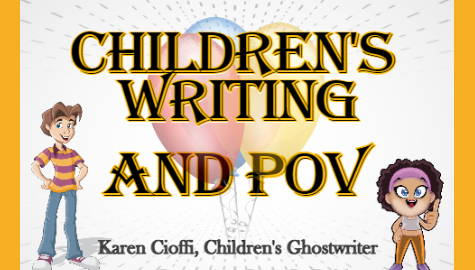Point of view (POV) refers to the narrator’s perspective on what’s going on. The POV is who’s telling the story. This will determine what the reader ‘hears’ and ‘sees’ in regard to the story. And it determines the ‘personal pronouns’ that will be used.
There are three main POVs in young children’s storytelling: first person, second person, and third person (limited). And, in each of these POVs, the protagonist (main character) must be in each scene – the story is told through his five senses. If he doesn’t see, hear, smell, taste, or touch it, it doesn’t exist in the story.
1. First person.
This POV has the protagonist narrating the story personally. Pronouns such as “I,” “my,” “me,” and “I’m,” are used.
Example from “Because of Winn-Dixie:”
That summer I found Winn-Dixie was also the summer me and the preacher moved to Naomi, Florida, so he could be the new preacher . . . (The protagonist, Opal, is talking to the reader – italics are mine for clarity.)
Notice the above isn’t in quotation marks for dialog. Dialog would be used if the protagonist talks to another character in the story or another character talks. See examples below:
“But you know what?” I told Winn-Dixie. (Opal is talking to her dog.)
“Well, I don’t know,” said Miss Franny. “Dogs are not allowed in the Herman W. Block Memorial Library.” (The librarian in the story is talking to Opal.)
Children’s book in first person POV:
“Because of Winn-Dixie (Kate DiCamillo)
“Green Eggs and Ham” (Dr. Suess)
“The Polar Express” (Chris Van Allsburg)
“Fly Away Home” (Eve Bunting)
2. Second person.
This POV uses “you” as the pronoun, referring to the reader, and isn’t used that often in young children’s writing. However, there are some authors who manage to pull it off very well.
An example of this POV from “How to Babysit Grandpa:”
Babysitting a grandpa is fun. If you know how. (The protagonist is talking to the reader, involving him. Italics are mine.)
Children’s books in second person POV:
“How to Babysit Grandpa” (Jean Reagan)
“My Mouth Is A Volcano” (Julia Cook)
“Secret Pizza Party” (Adam Rubin)
“The Book That Eats People” (John Perry)
3. Third person (limited).
This POV is probably the most popular in young children’s writing. Pronouns such as “he,” “she,” “its,” “they,” and “their” are used.
While this is similar to the other two POVs in that they’re all told from the protagonist’s point of view, in third person, the narrator (a third party) is telling the story. He’s privy to all the senses and emotions of the protagonist.
Here’s an example from “Walking Through Walls:”
“You will practice by walking through this brick wall. You must repeat the magic formula over and over as you go through it.”
Wang looked at the wall. He tightened his fists, clenched his jaw, and wrinkled his forehead. This is sure to hurt.
“Uh,” he paused, “Master, what will happen if I do say the words to the magic formula out loud?”
“Wang, you are trying to delay your task. It is a good question, though. Your tongue will cease its movement if you speak the words to the formula.”Wang’s eyes opened wide, and he flung his hands on top of his head. Never to talk again! I am sorry I asked for the formula. What if I slip?
The narrator is telling the reader what’s going on. Again, he’s privy to the protagonist’s thoughts, senses, and feelings.
Children’s books in third person POV:
“Walking Through Walls” (Karen Cioffi)
“Owen” (Kevin Henkes)
“Tops and Bottoms” (Janet Stevens)
“Stephanie’s Ponytail” (Robert Munsch)
Be consistent.
When writing for young children, it’s the author’s job to make sure the story is engaging and CLEAR (easy to understand). One quick way to lose the reader is to mix and match point of view within the story. Even if you slip just once, you may very well throw the reader off.
One easy error is to slip into a second person POV within a third-person story. How this might happen:
The third-party narrator is explains what the protagonist did, then adds in something like, “Can you believe it?”
That one little sentence has switched POVs and can cause confusion.
Remember to choose one POV and stick with it throughout your story.
There you have it: the three main points of view in young children’s storytelling. Which do you prefer?
Sources:
http://literarydevices.net/point-of-view/
http://www.childrensbookacademy.com/mondays-with-mandy-or-mira/second-person-point-of-view-in-picture-books
MORE ON WRITING FOR CHILDREN
Children’s Writing and Publishing Jargon – 11 of the Basics
Getting to Know Your Characters
Plot and Your Story – Four Formats

I’m a working children’s ghostwriter, rewriter, and coach. I can help turn your story into a book you’ll be proud to be the author of, one that’s publishable and marketable.
OTHER HELP I OFFER:
HOW TO WRITE A CHILDREN’S FICTION BOOK
A DIY book to help you write your own children’s book.
FICTION WRITING FOR CHILDREN eCOURSE
4-Weeks / 8 Sections Guided Self-Study Mentoring Program
You can contact me at kcioffiventrice@gmail.com.


7 thoughts on “Point of View and Children’s Storytelling”